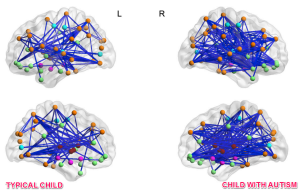“Our findings not only provide direct evidence for hyperconnectivity at the whole-brain level spanning multiple functional subsystems, but also demonstrate a link to core clinical symptoms in school-age children with ASD. More generally, this work challenges the notion of underconnectivity as the central neurobiological feature of ASD.”
A new study[1] examined the neural activity of both typical developing children, and children with autism. A team of researchers across three locations examined 110 children with a series of fMRI brain scans.
Autism affects nearly 1 in 88 children[2]. This study reversed findings from previous studies examining neural activity in the brain of adults with autism[3]. Researchers found significantly greater activity between neural connections. Several previous studies in adults reported weaker connections, leading to the belief that neurophysiological inactivity facilitated the diminished social communicative and increased repetitiveness of persons with autism—core criteria when diagnosing a person with autism[2].
The researchers believe the hyperactivity of signals found in children with autism inhibit the function of areas specifically responsible for communication and socialization.
“Drawing from these observations, it might not be too far fetched to speculate that the existing drugs used to treat epilepsy may be potentially useful in treating autism”
The authors presents epilepsy medication as a possible treatment. These findings may not only lead to new treatments, but also early detection. Lovaas found early intervention with intense behavioral techniques produced the best results, and lead some children on the spectrum to develop typically with their peers. The current age of diagnosis is three years old, and many authorities suggest parents should seek a diagnosis as early as two. The use of fMRI may provide a definitive diagnosis, and much early then two.
DISCUSSION AND QUESTIONS
The findings are encouraging. While there is clearly a genetic basis, from twin studies, scientist have yet to pinpoint a single gene causing autism. Further, with such a variety of symptoms it is possible many different genes play a role, as well as environmental factors—most likely in-vitro [2].
Perhaps, these factors cause neurophysiolgical impairments, and the hyper-connectivity between neurons is an attempt to compensate for the functional deficiency of areas within the brain—instead of hyperactivity drowning those areas, as the study suggest. My previous post examined consciousness, and how neural connectivity may be the activity we call consciousness. What other illnesses might be due to malfunctioning connectivity between neurons, and what other insight might be gathered by examining consciousness and neuro-connectivity?
Without understanding the physiological nature of autism, treatment has been difficult. Behavioral modification techniques have been successful, pioneered by Lovaas. Perhaps these techniques alter neural responses in persons on the spectrum, similarly to how learning strengthens and builds neural activity specific to that learning.
Understanding the neurobiology is critical to developing treatment and providing early detection for children with autism. Future studies might look at difference between severity, or certain symptoms, on the spectrum, or may look into how different treatments alter neural patterns in children with autism. Autism is rife with miracle cures from pseudoscience, and a better understanding of the disease will help deflate the claims of alternative-medicine practitioners and miracle-men, many attempting to benefit from parents desperate to help their child develop “normally.”
Follow me on twitter @getpsychedblog
TUNE-IN Mondays for new posts, and look for new resource sections on the site in the next few weeks!
[1] Supekar, K., Uddin, L. Q., Khouzam, A., Phillips, J., Gaillard, W. J., Kenworthy, L. E., Yerys, B. E. Vaidya, C. J., Menon, V. (2013). Brain hyperconnectivity in children with autism and its links to social deficits. Cell Reports, 5, 738.
[2] American Psychiatric Association. (2013). Autism Spectrum Disorder. In Diagnostic and statistical manual of mental disorders (5th ed.).
[3] Kleinhans, N. M., Richards, T., Sterling, L., Stegbauer, K. C., Mahurin, R., Johnson, L. C., Greenson, J., Dawson, G., Aylward, E. (2008). Abnormal functional connectivity in autism spectrum disorders during face processing. Brain. 131(4), 1000.
 Send to Kindle
Send to Kindle







